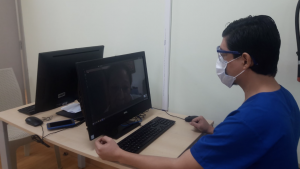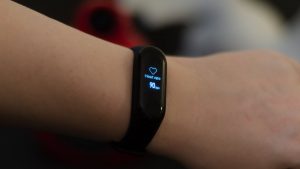24 The Emergence of Telemedicine
Jules Harper
24.1 Introduction
Keywords
- Telemedicine – the delivery of healthcare services, where distance is a critical factor, by all healthcare professionals using information and communication technologies for the exchange of valid information for diagnosis, treatment and prevention of disease and injuries, research and evaluation, and for the continuing education of healthcare providers, all in the interests of advancing the health of individuals and their communities (Mahar, 2018).
- Coronavirus Disease 2019 (COVID-19) – infectious disease caused by severe acute respiratory syndrome coronavirus 2 (SARS-CoV-2).
- Pandemic – a disease that spreads across several countries or continents, usually affecting a large number of people. The COVID-19 pandemic is an ongoing global pandemic that was initially reported in Wuhan, China in December of 2019
Learning Objectives
By the end of this chapter, students should be able to:
- Understand what telemedicine is and the impact it has left on society throughout history.
- Describe the role of telemedicine in the COVID-19 pandemic and in potential public health emergencies.
- Discuss the benefits and limitations of the technology in healthcare.
- List the areas of weakness and necessary improvements in order to fully adopt telemedicine in the future.
The future of telemedicine is promising. The initial goal behind the technology was to provide medical treatment and greater access to healthcare for individuals living in underserved rural areas. Nonetheless, at the height of the COVID-19 pandemic in April 2020, when the Centers for Disease Control (CDC) advised all healthcare systems to limit inessential activity, telemedicine became the response for non-emergency healthcare (Colbert, 2020). It was a critical method in treating patients while simultaneously reducing the risk of disease transmission.
There are both benefits and limitations in modern telemedicine applications. Some of the benefits include reduced healthcare costs, greater patient access to providers, enhanced quality and continuity of care, and more convenient treatment that results in less travel expenses and lost work time for patients (Clark, 2010). On the other hand, telemedicine is still not a substitute for personal interaction in clinical healthcare; with the implementation of digital health, the ‘human touch’ is abandoned and empathy is less transparent (Almallah, 2020). Telemedicine services expanded and accelerated during the COVID-19 outbreak; if certain limitations are addressed, this emerging technology can provide benefits and advancements in healthcare that are outside of the pandemic period.

“Doctor attending by teleconsultation” by Ceibos is licensed under CC BY-SA 4.0
24.2 What is Telemedicine?
Key Takeaway
Telemedicine is the use of electronic information and communication technologies to deliver healthcare at a distance between the patient and the healthcare provider. Geographical separation, along with the socioeconomic barriers that hinder healthcare access in both rural and urban areas, are two of the obstacles that telemedicine helps address (Clark, 2010). With consultations now being conducted through the patient’s smartphone or computer, these services allow the most advanced, specialized medical practices to be available for all persons, despite their location or at unpredicted times (Clark, 2010).
There are two types of telemedicine programs: synchronous programs and asynchronous programs. Synchronous programs are live two-way interactions between the patient and healthcare professional, whereas asynchronous programs are not live and involve the sending of images, videos, and other clinical information for the healthcare professional to view and respond later in time (Mahar, 2018). For a typical telemedicine visit, the patient will first have to download the telemedicine software (such as Zoom, Cisco, Skype, etc.) and login to make an appointment. At the scheduled time, the patient and physician will join the consultation based on the meeting ID. Through this audio or video communication platform, the physician will assess, diagnose, and treat the patient (Bokolo, 2020).
For a virtual visit to be equally meaningful as a traditional visit, it requires the same amount of rigorous investigation and attention. In order for the consultation to be legal, billable, and Health Insurance Portability and Accountability Act compliant, comprehensive documentation is essential. In addition, sufficient documentation is especially important in assessing, diagnosing, or treating the patient (Colbert, 2020). Even if clinicians virtually translate all these same elements of a standard patient encounter, critics of telemedicine claim that the patient-physician relationship suffers and the accuracy of the physical exam is limited.

“Mockup on mobile phone holding by female doctor.” by Ilmicrofono Oggiono is licensed under CC BY-SA 2.0
24.3 History of Telemedicine
Key Takeaway
Telemedicine was initially introduced to provide healthcare access to those living in rural and underserved areas. As early as 1877, telemedicine practices were seen through the use of the telephone. By 1927, the live video consultation was first demonstrated between a patient and physician. Between 1973 and 1977, the National Aeronautics and Space Administration (NASA) partnered with Indian Health Services in Papago, Arizona to establish STARPAHC (Space Technology Applied to Rural Papago Advanced Health Care). This program would supply medical treatment through a mobile health unit that practiced two-way video, audio, and data communications technologies (Clark, 2010). This point in history had strongly suggested telemedicine’s potential for the future.
Nevertheless, widespread acceptance and implementation of the technology was delayed due to lack of proper equipment, high costs of functioning, little physician interest, and limited insurance coverage. In the 1980s, telemedicine grew popular again as new applications were being developed for battlefield medicine. At this time, when the United States armed forces started using telemedicine, the video-teleconferencing enabled physicians to care for soldiers on the battlefield (Clark, 2010). By 2003, the U.S. Department of Veterans Affairs (VA) officially adopted Telehealth and went nationwide (Colbert, 2020). Seven years later, in an attempt to improve healthcare costs, the country as a whole witnessed the rapid expansion of telemedicine services.

“Telemedicine VIP Day” by U.S. Army Combat Capabilities Development Command C5ISR Center is licensed under CC BY 2.0
The massive acceleration in telemedicine implementation did not occur until 2020. In 2019, the first case of Coronavirus Disease 2019 (COVID-19) was identified in Wuhan, China. This infectious disease, caused by severe acute respiratory syndrome coronavirus 2 (SARS-CoV-2), spread across the globe, infecting a large number of individuals. On March 11, 2020, the World Health Organization (WHO) declared the COVID-19 outbreak as a pandemic. In an effort to limit non-essential activity in hospitals, telemedicine was widely adopted. The technology slowed the spread of COVID-19. It reduced the movement of people within hospitals and lowered the risk of intra-hospital infection. It decreased the time required to obtain a diagnosis and begin self-quarantining. It facilitated close follow-up appointments with patients that could easily be monitored from home, thus avoiding oversaturation of health facilities (Bokolo, 2021). In the COVID-19 pandemic, telemedicine proved itself useful in a national emergency. The technology led to the rapid deployment of many virtual healthcare providers, triage (emergency assessment) facilitation, and a reduced risk of disease transmission (Almallah, 2020). The success of the technology during the outbreak influenced many patients to start permanently preferring telemedicine services over clinical visits.

“1317” by UNICEF Ukraine is licensed under CC BY 2.0
24.4 Telemedicine’s Impact on Society
Key Takeaway
24.4.1 Advantages of Telemedicine
Telemedicine’s initial purpose was to provide easier and better healthcare access for those living in rural and urban areas. Additionally, those without reliable transportation, or even those who may be too sick to travel, directly benefit from these video and audio consultations. Nonetheless, the technology has provided more benefits than healthcare ever imagined it to. Telemedicine has proven to lower healthcare costs, decrease the financial impact of no-shows from patients, avoid the unnecessary office or emergency room visits and hospital admissions, and enable primary care providers to conduct appointments without additional office staff, thus extending office hours and availability. It has also shown to optimize staff distribution and healthcare resources within healthcare systems and improve patient compliance and engagement (Mahar, 2018). With a video encounter, the healthcare professional can still observe the patient’s facial expressions and note any cues from their nonverbal behaviors.
The technology finally gives patients and providers the opportunity to communicate at a distance. In fact, the element of distance seems to enhance the encounter, as patients often feel more comfortable in their home environment rather than in a sterile office environment (Mahar, 2018). In one particular research study, out of the 1,734 patients that participated in a MinuteClinic telemedicine visit, 95% of them were “very satisfied with the quality of the healthcare they received and rated telemedicine as better than or just as good as a traditional visit” (Polinksi, 2016, p. 273). From this study, the one significant predictor of patient preference for telemedicine was medical insurance. Telemedicine services provide quality care at lower costs, thus explaining why participants with no medical insurance were more likely to prefer telemedicine as opposed to a traditional visit.
24.4.2 Limitations of Telemedicine
There are various benefits offered by telemedicine, but there also exist limitations. Telemedicine is not a substitute for the personal interaction in clinical medicine. The empathy and ‘human touch’, which are paramount in clinical medicine, are almost absent in digital health (Almallah, 2020). An original research study conducted qualitative interviews to learn more about patients’ perspectives of clinical video telemedicine (Gordon, 2020). What they discovered was that patients using telemedicine struggled in establishing a provider-patient relationship, felt as if their providers paid less attention to them, and faced barriers to speak up and ask questions. Researchers believe that with more effort and adequate training for professionals, they can learn how to make patients feel more comfortable with the virtual treatment process (Bokolo, 2020).
Through virtual visits, physicians cannot perform a complete physical evaluation on the patient. This leaves patients feeling distressed about errors in their care because of the perceived difficulty in completing the physical exam (Gordon, 2020). Additionally, a patient description of his or her issue may not be as informative or accurate as the in-person. The physician cannot quickly access diagnostic testing or imaging for the patient (Colbert, 2020). The physician is unable to evaluate vision changes or palpate for abdominal pain or organ enlargement. In the future, technological improvements in telemedicine may need to be directed towards improving the abilities to conduct physical exams via video.
24.5 Future Directions for Telemedicine
Key Takeaway
In looking towards the future, telemedicine aims to focus on individuals with complex chronic conditions (such as hypertension, diabetes, or chronic obstructive pulmonary disease), as they likely represent the most relevant group to telemedicine. Nearly 50% of all American adults have at least one chronic disease, which thus explains why chronic disease accounts for 75% of total healthcare expenditure (Mahar, 2018). Their required clinical follow-up visits can be replaced by remote check-up appointments. As telemedicine services accelerate rapidly in the home setting, the number of emergency room visits and admissions to the hospital will decrease. Individuals with chronic conditions can remain in the comfort of their homes, while having monitoring devices measure their blood pressure, heart rate, and blood glucose level (Clark, 2010). These monitoring devices or mobile sensors can include smartwatches, thermometers, and oxygen monitors (Bokolo, 2021). The information will be transmitted across phone lines to healthcare providers, ensuring constant, quality, and cost-effective care.
For the future success of telemedicine, there are practical points and logistics to consider. Even though telemedicine is usually delivered through smart devices, both patients and physicians still require setup instruction. Healthcare providers must be adequately trained in delivering medical care remotely. Additionally, to have reliable telecommunications, Internet access, a strong Wi-Fi signal, and sufficient bandwidth are crucial (Bokolo, 2020). If there is poor video quality, patients will be less engaged and less satisfied. Inadequate bandwidth is usually an issue for residents in rural areas who do not have strong Internet access (Bokolo, 2021). To effectively adopt telemedicine in the future, it is important to work towards educating the technologically illiterate patients, but also improving broadband Internet speed.

“Xiaomi Band heart-rate monitor” by Daniel Aleksandersen is licensed under CC BY-SA 2.0
Case Study: Case Study: Nobody Enjoys Driving!
Mary is a sophomore undergraduate student at Clemson University and originally from Charleston, South Carolina. In fifth grade, Mary was diagnosed with attention-deficit/hyperactivity disorder (ADHD). Every three months, Mary would meet with her Family Medicine Specialist for a check-up appointment and to obtain her ADHD medication prescriptions. Ever since she started her education at Clemson University, however, she would have to spend four hours driving home for her check-up appointment.
During the COVID-19 pandemic, her physician started implementing video telemedicine for Mary’s check-up appointments. This lowered the risk of either Mary or her physician contracting the virus. She would use a thermometer to measure her temperature, her Apple Watch to measure her heart rate, and a scale to measure her weight. Through the FaceTime visit, Mary and her physician would communicate and address any changes in her health or how her ADHD medication was affecting her.
When Clemson University allowed for students to return to campus, Mary’s physician allowed her to continue scheduling virtual consultations rather than in-person visits. In order to obtain her prescriptions every three months, Mary was no longer required to travel a total of eight hours, spend a significant amount of her savings on gas, or miss any of her classes during the week. She continues to use the FaceTime application on her computer to meet with her physician, all in the comfort of her new Clemson home.
Chapter Summary
Telemedicine can be classified as any technology that delivers healthcare electronically and from a distance. It has expanded healthcare access to rural and urban areas, to soldiers on the battlefield, to those in a pandemic, or to those without transportation. Despite the limitations that need to be addressed for the future of telemedicine, the benefits that the technology offers are numerous and impactful. Health care providers and specialized services can now be reached across states and across international borders.
Review Questions
1. In 2010, the United States saw telemedicine services rapidly expand. What was the main reason for this widespread acceptance and implementation of telemedicine in healthcare systems?
A. Physicians were given strict schedules.
B. The United States was looking for ways to improve healthcare costs.
C. The COVID-19 pandemic influenced healthcare systems to limit non-essential clinical visits in hospitals.
D. Patients wanted their encounters with professionals to be more private than the hospital setting.
2. Which of the following is one of the benefits that telemedicine services provided during the COVID-19 pandemic?
A. Telemedicine helped reduce the risk for transmission of COVID-19.
B. Telemedicine facilitated healthcare access while keeping patients safe at home through social distancing.
C. Telemedicine was crucial for non-emergency healthcare.
D. All of the above.
3. Which of the following is a limitation in telemedicine services?
A. Complete and accurate physical examinations.
B. The travel expenses and transportation required to meet with the healthcare provider.
C. The less digitally literate patients that pose an obstacle to access.
D. Patients in underserved areas that now have easier and convenient access to healthcare.
4. Which of the following is a suggested improvement in telemedicine services, specifically for patients in rural areas?
A. Providing more rural residents with monitoring devices and mobile sensors.
B. Improving broadband Internet speed.
C. Encouraging patients to attend their video consultations at a location with stronger Wi-Fi connection.
D. Teaching patients how to speak different languages.
Answers:
- B
- D
- C
- B
Food for Thought
- When weak Internet connections lead to poor video quality, researchers claim that patients exhibit decreased engagement and reduced patient satisfaction. How do you think this affects the patient-physician relationship? How could this affect the rapport built among patients and physicians?
- How may patients who cannot afford or access sources of technology communications be affected by telemedicine services?
References
Almallah, Y. Z., & Doyle, D. J. (2020). Telehealth in the time of Corona: ‘doctor in the house’. Internal medicine journal, 50(12), 1578–1583. https://doi.org/10.1111/imj.15108
Bokolo Anthony Jnr (2020). Use of Telemedicine and Virtual Care for Remote Treatment in Response to COVID-19 Pandemic. Journal of medical systems, 44(7), 132. https://doi.org/10.1007/s10916-020-01596-5
Bokolo A. J. (2021). Exploring the adoption of telemedicine and virtual software for care of outpatients during and after COVID-19 pandemic. Irish journal of medical science, 190(1), 1–10. https://doi.org/10.1007/s11845-020-02299-z
Clark, P. A., Capuzzi, K., & Harrison, J. (2010). Telemedicine: medical, legal and ethical perspectives. Medical science monitor : international medical journal of experimental and clinical research, 16(12), RA261–RA272.
Colbert, G. B., Venegas-Vera, A. V., & Lerma, E. V. (2020). Utility of telemedicine in the COVID-19 era. Reviews in cardiovascular medicine, 21(4), 583–587. https://doi.org/10.31083/j.rcm.2020.04.188
Gordon, H. S., Solanki, P., Bokhour, B. G., & Gopal, R. K. (2020). “I’m Not Feeling Like I’m Part of the Conversation” Patients’ Perspectives on Communicating in Clinical Video Telehealth Visits. Journal of general internal medicine, 35(6), 1751–1758. https://doi.org/10.1007/s11606-020-05673-w
Mahar, J. H., Rosencrance, J. G., & Rasmussen, P. A. (2018). Telemedicine: Past, present, and future. Cleveland Clinic journal of medicine, 85(12), 938–942. https://doi.org/10.3949/ccjm.85a.17062
Polinski, J. M., Barker, T., Gagliano, N., Sussman, A., Brennan, T. A., & Shrank, W. H. (2016). Patients’ Satisfaction with and Preference for Telehealth Visits. Journal of general internal medicine, 31(3), 269–275. https://doi.org/10.1007/s11606-015-3489-x
The delivery of healthcare services, where distance is a critical factor, by all healthcare professionals using information and communication technologies for the exchange of valid information for diagnosis, treatment and prevention of disease and injuries, research and evaluation, and for the continuing education of healthcare providers, all in the interests of advancing the health of individuals and their communities.
An infectious disease that spreads as a virus and often affects the respiratory system, producing shortness of breath, cough, and congestion among many other symptoms.
A disease that spreads across several countries or continents, usually affecting a large number of people.

